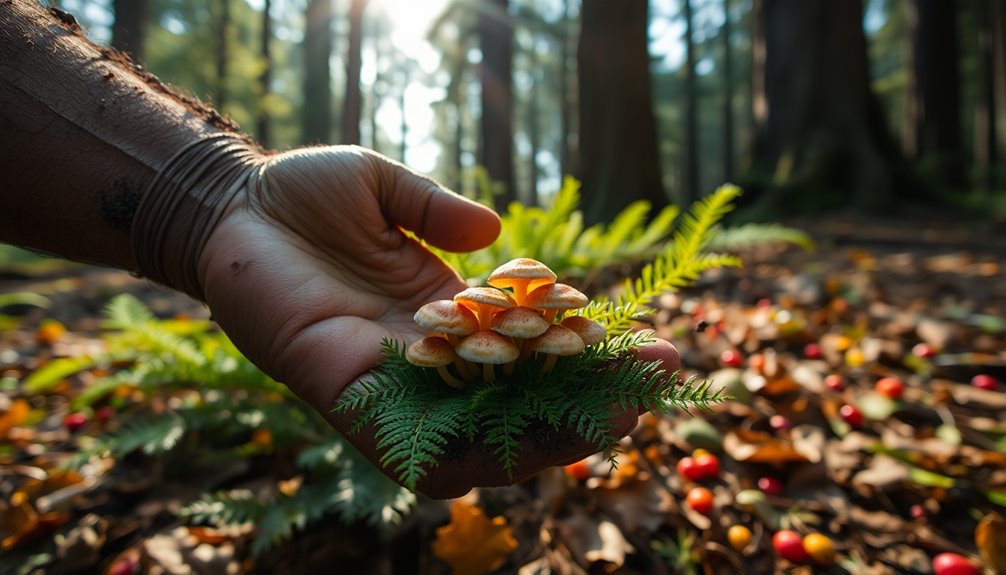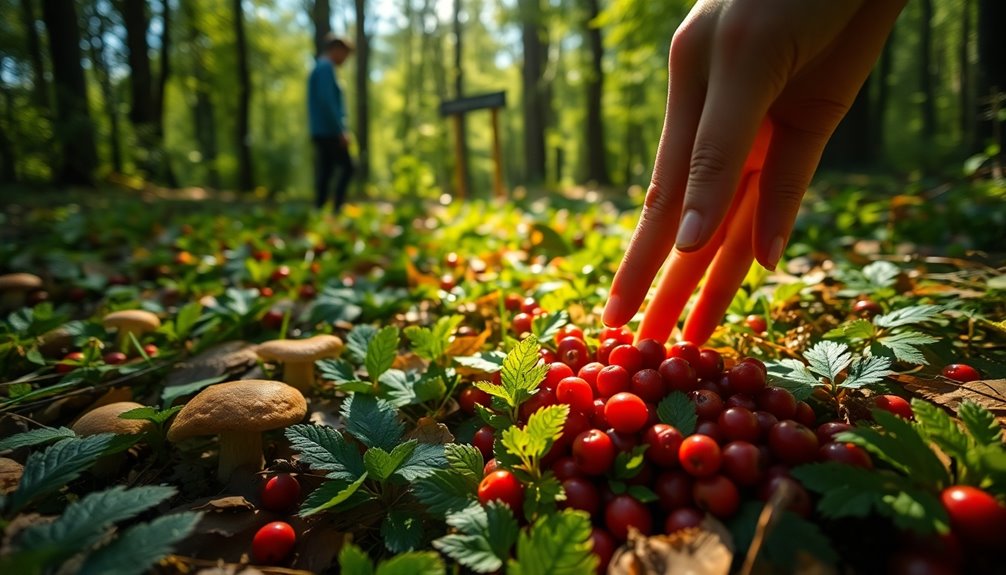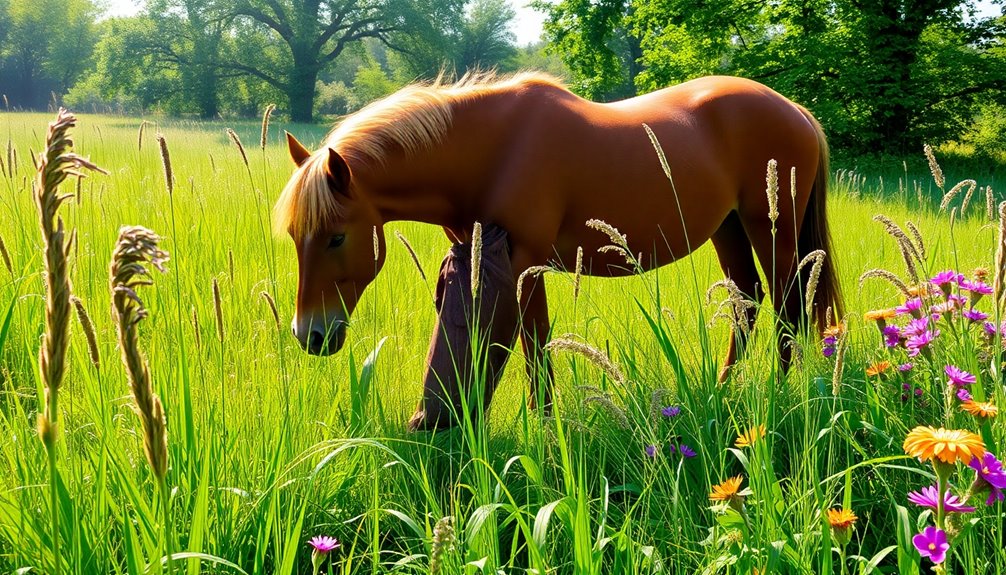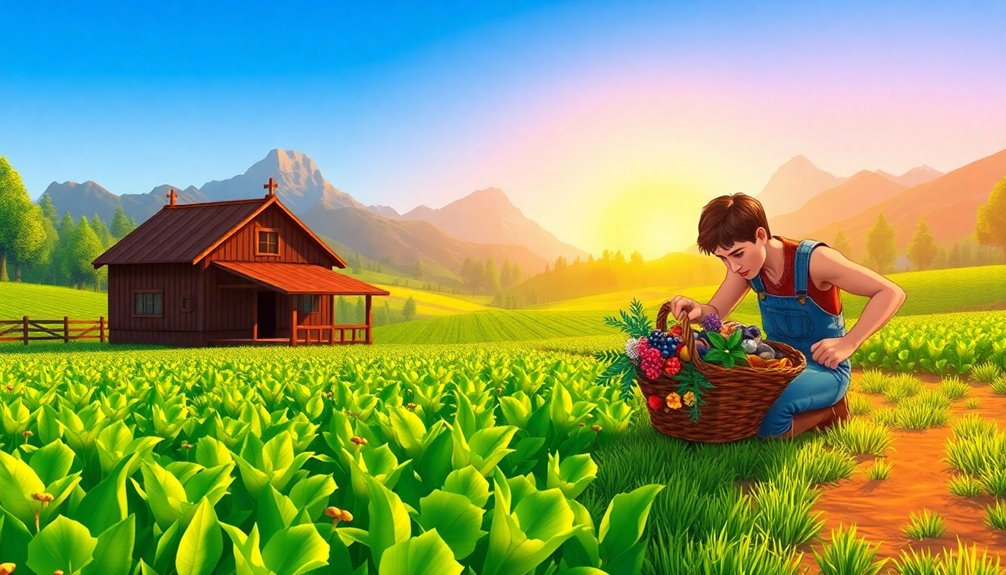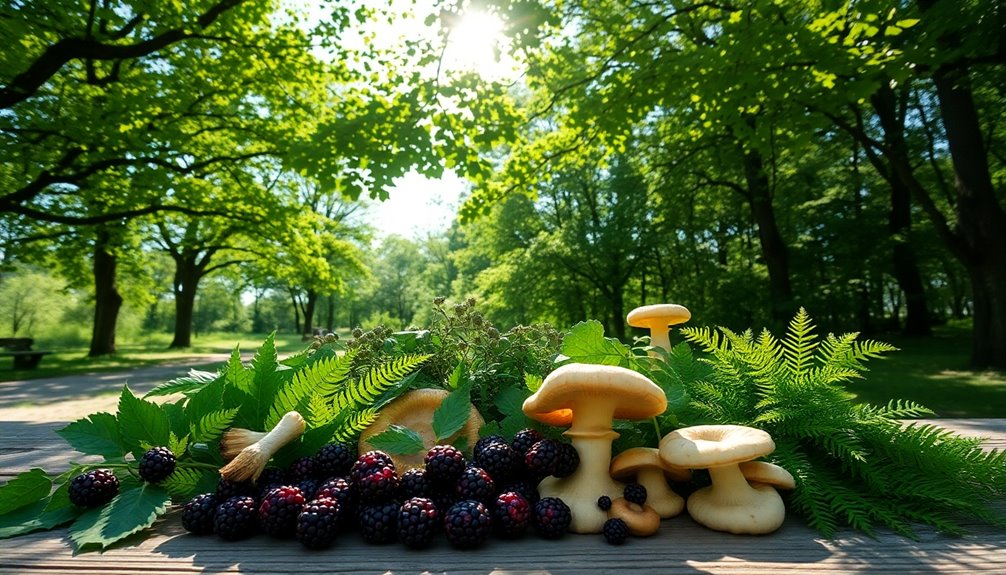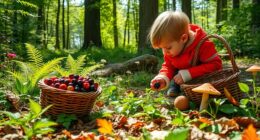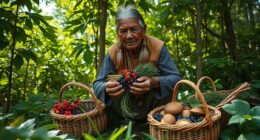Foraging is humanity's oldest hobby, dating back to our earliest ancestors. You've spent over 99% of your existence gathering wild food before agriculture emerged around 12,000 years ago. Early humans relied on foraging as their primary means of sustenance, forming tight-knit communities that supported each other. This practice isn't just about survival; it's shaped culture and culinary traditions for thousands of years. Today, you see a resurgence in foraging, blending ancient knowledge with modern appreciation for nature's bounty. If you're curious about the evolution and significance of foraging, there's so much more to explore!
Key Takeaways
- Foraging is humanity's oldest subsistence method, dating back over 2 million years before the advent of agriculture around 12,000 years ago.
- Early humans relied on hunting and gathering, with foraging as the primary means of survival for over 90% of human history.
- Indigenous peoples developed extensive knowledge of local flora and fauna, passing this information down through oral traditions, especially among women.
- The decline of foraging knowledge occurred during the Victorian era, but a resurgence emerged during the 1960s-70s counterculture movement.
- Modern foraging combines ecological awareness, health consciousness, and culinary exploration, reviving this ancient practice in contemporary society.
Origins of Foraging
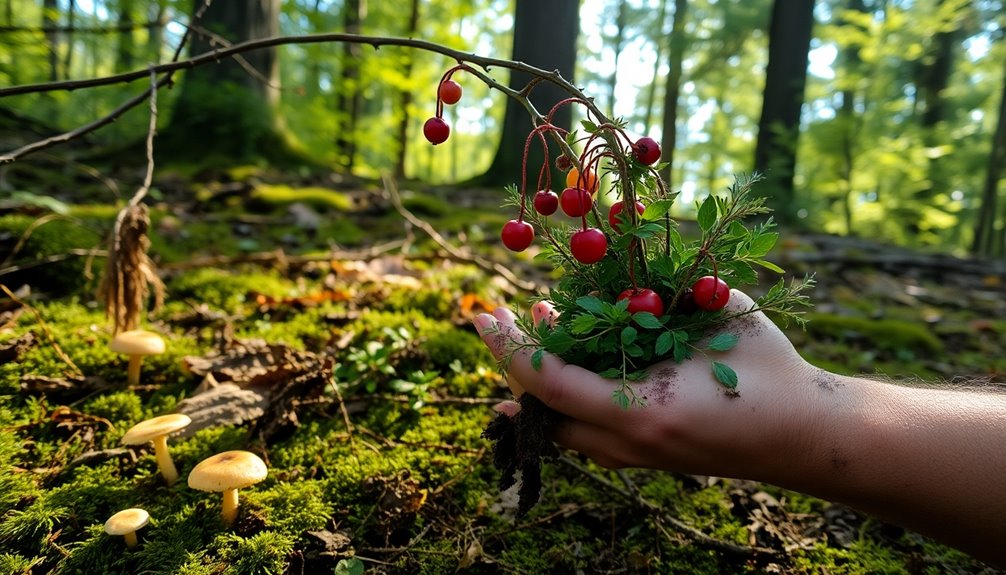
Foraging stands as humanity's oldest subsistence method, with over 99% of our existence relying on gathering wild food long before agriculture emerged. You can trace the origins of foraging back to our early ancestors, who thrived by hunting and gathering wild foods. This method allowed indigenous peoples to adapt to diverse environments, utilizing their profound knowledge of local flora and fauna.
Even with the rise of agriculture around 12,000 years ago, foraging didn't vanish; it remained an essential source of nutrition for many communities. Historical records show that herders and farmers often turned to foraging during times of hardship and food scarcity, highlighting its enduring significance.
Ethnographic studies reveal that foraging practices vary widely, shaped by cultural beliefs and local environmental conditions.
Interestingly, the late Victorian era saw a decline in foraging knowledge due to industrialization and a growing preference for exotic foods. However, your curiosity about wild foods could be reignited by the 1960s-70s hippy movement, which sparked a revival of interest in traditional foraging practices.
Today, the legacy of foraging continues to connect you with nature and your ancestors.
The Role of Hunter-Gatherers
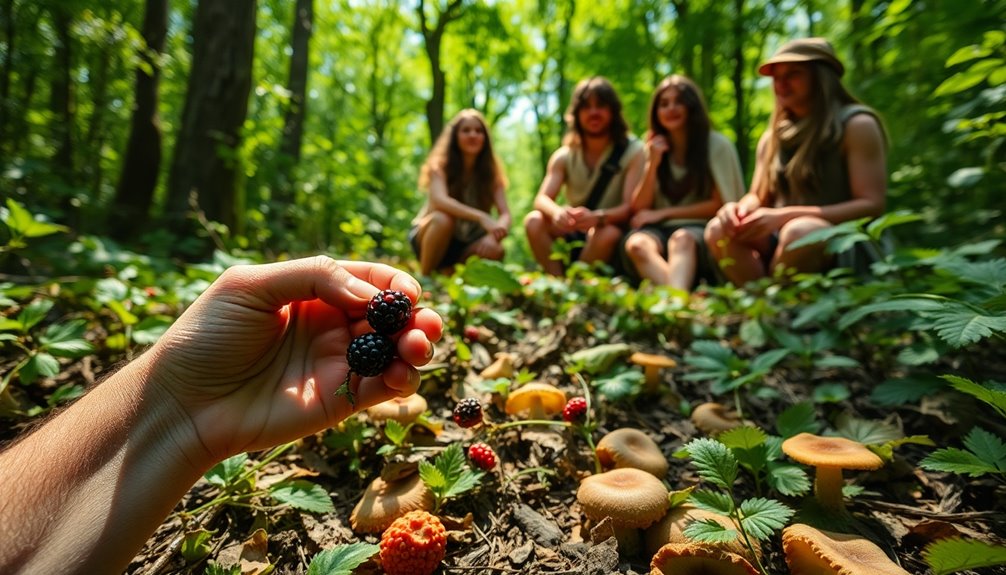
Throughout most of human history, hunter-gatherers played an essential role in shaping societies and ecosystems. These groups relied on foraging as their primary subsistence strategy, gathering plant foods and hunting game to meet their dietary needs. For over 90% of human history, this lifestyle characterized early communities, allowing flexibility and adaptability in resource use.
Hunter-gatherer groups typically consisted of a few dozen individuals, fostering strong kinship bonds and communal support. This close-knit structure enabled them to navigate food shortages effectively, relying on mutual exchange and resource sharing to maintain balance within their communities.
Notably, gender roles in these societies were more fluid than previously thought. Studies reveal that women participated in hunting in 79% of modern hunter-gatherer societies, defying traditional views that often portray them solely as gatherers.
Despite some level of inequality, indicated by an average Gini coefficient of 0.25, communal sharing remained a cornerstone of their economic systems. The resilience and cooperation displayed by hunter-gatherers not only sustained their communities but also laid the foundation for future societal developments.
Their influence endures, reminding us of the importance of foraging in human history.
Social Structures in Foraging
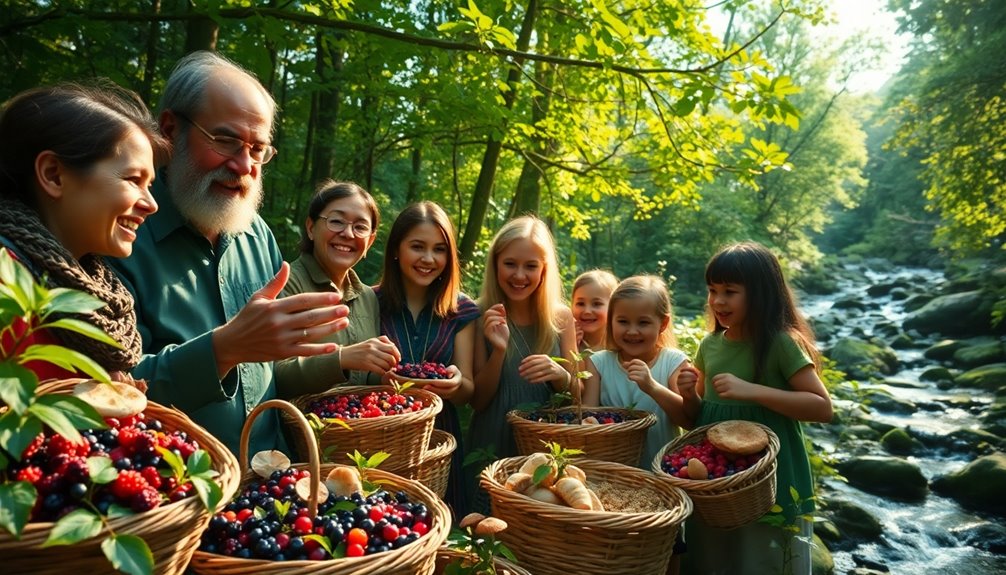
When you look at foraging societies, you'll notice their small groups are tightly knit through kinship and shared responsibilities.
Resource sharing is a cornerstone of their community, promoting cooperation and equality among members.
Leadership often shifts based on the situation, highlighting the dynamic nature of decision-making in these egalitarian structures.
Group Dynamics and Kinship
In hunter-gatherer societies, social structures play a crucial role in survival and community cohesion. These groups typically consist of small, mobile units where multirelational kinship ties foster strong bonds and cooperative behaviors. This interconnectedness is fundamental for overcoming challenges in their environment.
The social structures in foraging communities are generally egalitarian. Leadership is situational, often determined by expertise rather than a fixed hierarchy. This flexibility guarantees that the most knowledgeable individuals guide the group during critical tasks, enhancing group efficiency.
Resource sharing is a cornerstone of these societies. By pooling resources, members reinforce communal support and solidarity, assuring that everyone benefits from collective efforts. Age equality is also prevalent, as communal practices diminish social hierarchies, allowing all members—regardless of age—to contribute and participate.
Gender roles in these societies are distinctly fluid. Women often hunt alongside men, showcasing a collaborative approach to subsistence in about 79% of modern hunter-gatherer societies.
This collaboration highlights how kinship ties and social structures work together to create resilient communities, critical for thriving in the unpredictable wild.
Resource Sharing Practices
Resource sharing practices form the backbone of social structures in foraging communities, where pooling resources is crucial for survival. In these egalitarian societies, individuals frequently share their foraged and hunted goods, fostering cooperation and reducing social hierarchies. This communal approach enhances food security and strengthens bonds among kinship groups.
Key aspects of resource sharing in foraging communities include:
- Collective well-being: The act of sharing reinforces mutual dependence among group members.
- Ritualized sharing: Many societies develop specific rituals around resource sharing, further solidifying social ties.
- Sustainable practices: Shared responsibility for resource management promotes environmental health and guarantees future food availability.
- Social cohesion: Resource sharing nurtures a sense of community, crucial for group survival.
- Reduced inequality: By minimizing social hierarchies, these groups encourage equal access to resources.
In essence, resource sharing isn't just a survival strategy; it's a fundamental practice that shapes the social fabric of foraging societies, emphasizing the importance of cooperation and collective well-being.
Through these practices, foragers create resilient communities, highlighting the interconnectedness of their lives and the resources they depend on.
Leadership and Decision-Making
Leadership in foraging societies is dynamic and context-driven, with individuals stepping up as leaders based on situational needs rather than holding fixed roles. This fluidity reflects the egalitarian ethos of hunter-gatherer societies, where everyone's input matters. Kinship and band membership greatly influence decision-making processes, ensuring that social connections guide collective actions.
In these groups, decision-making often involves consensus. You'll find that discussions shape agreements on critical matters, such as resource sharing and hunting strategies. Contrary to traditional views that suggest a rigid division of labor—where men primarily hunt and women gather—research shows that women actively participate in hunting in around 79% of modern foraging societies. This inclusivity enriches leadership dynamics and enhances overall group efficacy. Furthermore, successful decision-making is often built on the principles of trust and communication, which are vital for maintaining group cohesion.
Moreover, leadership practices are adaptive, showcasing flexibility in response to environmental challenges and resource availability. When faced with new situations, individuals with relevant skills naturally emerge as leaders, demonstrating that effective leadership in these societies is less about hierarchy and more about communal resilience. As foraging practices vary across regions, understanding the local wild edibles available can also influence group dynamics and decisions.
Understanding these structures can deepen your appreciation for the complexities of hunter-gatherer decision-making and leadership.
Evolution of Foraging Practices
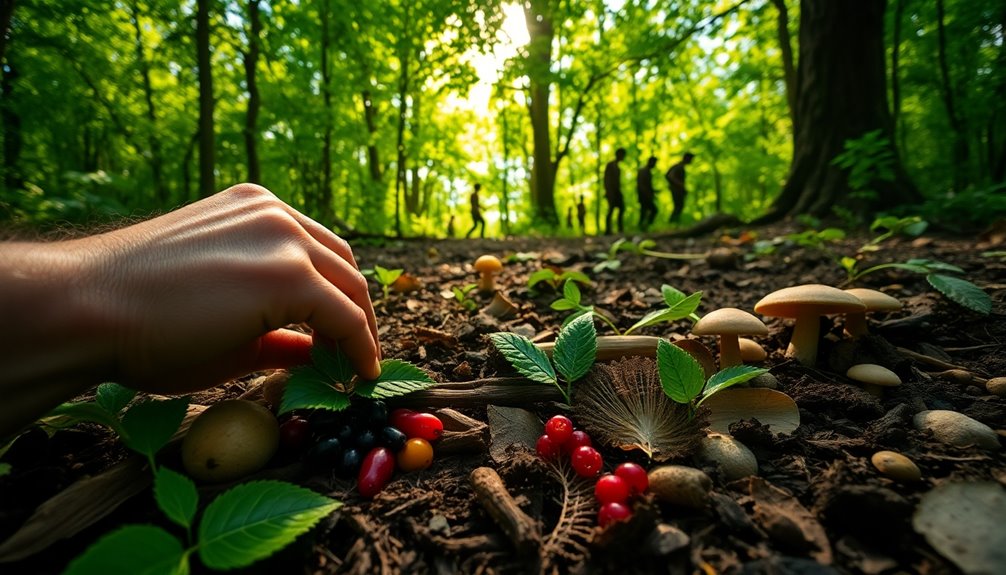
As you explore the evolution of foraging practices, you'll uncover how prehistoric techniques laid the groundwork for our relationship with food.
You'll also see how foraging's cultural significance has shaped communities throughout history and continues to influence modern culinary trends.
Today, a resurgence in foraging reflects a blend of ancient wisdom and contemporary values, making it a fascinating journey to examine.
Prehistoric Foraging Techniques
Foraging, a fundamental aspect of human survival, showcases the ingenuity of our prehistoric ancestors in adapting to their environment. You'd find them utilizing a variety of resources, from wild edible plants to insects and fungi. Their knowledge of the local ecosystem was vital, as they relied on seasonal availability to thrive.
Here are some key prehistoric foraging techniques employed by human hunter-gatherers:
- Utilization of Edible Plants: They identified and harvested a range of plants that provided essential nutrients.
- Persistence Hunting: This technique involved chasing prey over long distances, capitalizing on endurance.
- Fishing Tools: The development of fishing nets and harpoons around 80,000 to 70,000 years ago marked significant advancements.
- Small Game Hunting: Communities began to incorporate small game into their diets, diversifying their food sources.
- Regional Adaptations: Foraging practices varied based on climate and available resources, allowing groups to tailor their strategies.
These techniques not only guaranteed survival but also laid the groundwork for the eventual shift to more complex subsistence strategies.
Understanding these practices gives you insight into the resilience and creativity of our ancestors.
#
Cultural Significance of Foraging
Throughout history, foraging has woven itself into the cultural fabric of societies, reflecting not just survival but also community identity and values. For over 99% of our existence, foraging served as the primary method for obtaining food plants, shaping how communities interacted with their environment.
In the late Victorian era, a shift toward technological progress led to a decline in these practices, as people began favoring exotic foods over native wild species.
However, the 1960s and 70s saw a resurgence in foraging, influenced by the counterculture movement that championed health and ethical eating. Books like Richard Mabey's "Food for Free" played an essential role in rekindling interest in wild food sources. This knowledge, traditionally passed down orally, especially among women, faced challenges due to ecological changes and industrial farming, which reduced the availability of foraged plants.
Today, contemporary foraging blends ancient practices with modern culinary trends. Wild foods are now often seen as exotic and high-status items, showcased on social media, reflecting a renewed appreciation for the cultural significance of foraging in human living.
This evolution underscores how deeply intertwined foraging is with our identity and values.
Modern Foraging Revival
Reviving ancient practices, modern foraging has captivated a new generation enthusiastic to reconnect with nature and food sources. As concerns about food sustainability rise, many of you are diving into foraging, blending age-old traditions with contemporary culinary trends.
The revival began in the 1960s and 70s, fueled by the hippy movement and Richard Mabey's influential book, "Food for Free." Today, you might see foraged ingredients on high-end restaurant menus, showcasing their status in modern cuisine. Moreover, the principles of educational philosophies guide foragers in understanding the importance of sustainable and responsible practices while gathering wild foods. This awareness not only enhances your foraging skills but also aligns with the idea of personal growth through conscious living. Additionally, foragers often seek out fiber-rich foods to support their digestive health.
Here are some key elements of the modern foraging revival:
- Health Consciousness: Many foragers seek organic, nutrient-rich food, often incorporating nutrient-dense options like seeds to enhance their meals.
- Culinary Exploration: You experiment with unique flavors and ingredients.
- Social Connection: Foraging often becomes a communal activity, enhancing bonds.
- Ecological Awareness: You recognize the importance of sustainability in food sourcing.
- Digital Sharing: Social media platforms help spread foraging knowledge and experiences.
As modern humans embrace this revival, it's essential to preserve foraging knowledge and promote ecological sustainability, ensuring that this ancient hobby thrives for generations to come. Additionally, foragers often incorporate omega-3 rich seeds to enhance their meals, further connecting with the health-conscious aspect of modern culinary practices.
Foraging and Gender Dynamics
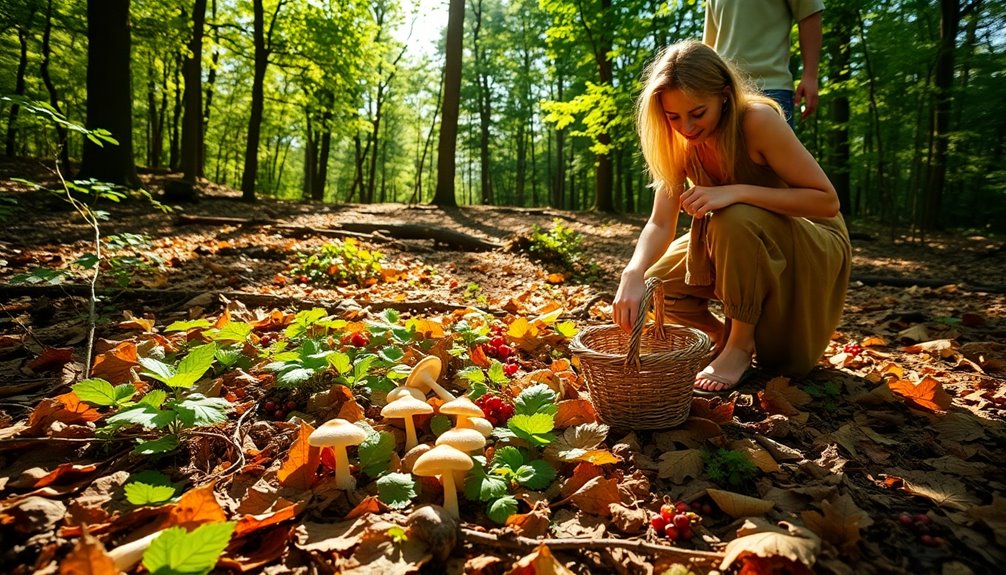
In the domain of foraging, traditional stereotypes about gender roles are increasingly challenged by evidence from modern hunter-gatherer societies. Research shows that women participate in hunting in 79% of these groups, contradicting the belief that only men hunt large game while women gather.
In fact, the division of labor in hunter-gatherer communities is often fluid, with both genders engaging in a variety of foraging and hunting activities. This collaborative approach fosters high levels of gender equality, as shared responsibilities in resource management lead to reduced social hierarchies.
You'll notice that age equality also thrives in these societies, where communal sharing practices promote inclusivity among different age groups.
Moreover, the emergence of specialization in hunting and gathering activities around 80,000 to 70,000 years ago reflects evolving gender dynamics and the development of specialized tools used by both men and women.
Modern Foraging Trends
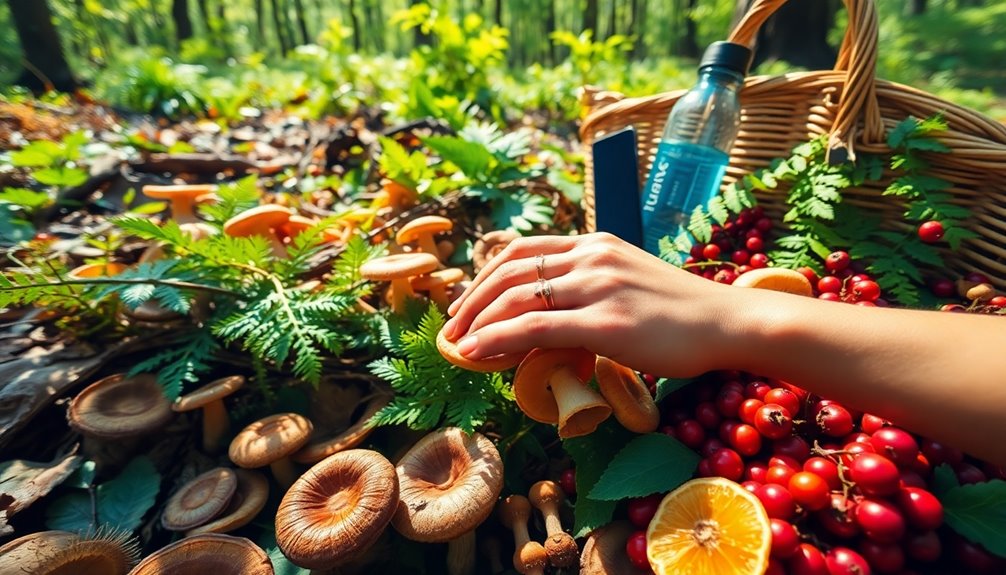
Foraging is experiencing a vibrant renaissance, especially as social media platforms like TikTok and Instagram showcase the beauty and bounty of wild foods.
This modern foraging trend reflects your desire to reconnect with nature, local communities, and healthier food sources. You're not just gathering; you're embracing sustainability and environmental awareness. Incorporating nutritional diversity through foraged ingredients can enhance your meals, providing unique flavors and health benefits.
Here are some key aspects of today's foraging culture:
- Community Engagement: Connect with local foraging groups and share your experiences online.
- Culinary Innovation: Experience high-end dishes featuring foraged ingredients in renowned restaurants.
- Educational Resources: Attend workshops that cover foraging's cultural, medicinal, and ethical significance.
- Responsible Harvesting: Learn to take only a small percentage from any patch, ensuring ecosystem health.
- Nutritional Diversity: Discover the variety of wild foods that can enhance your diet.
- Foraging Skills: Mastering identification skills is essential for distinguishing edible varieties from toxic ones.
Environmental Considerations
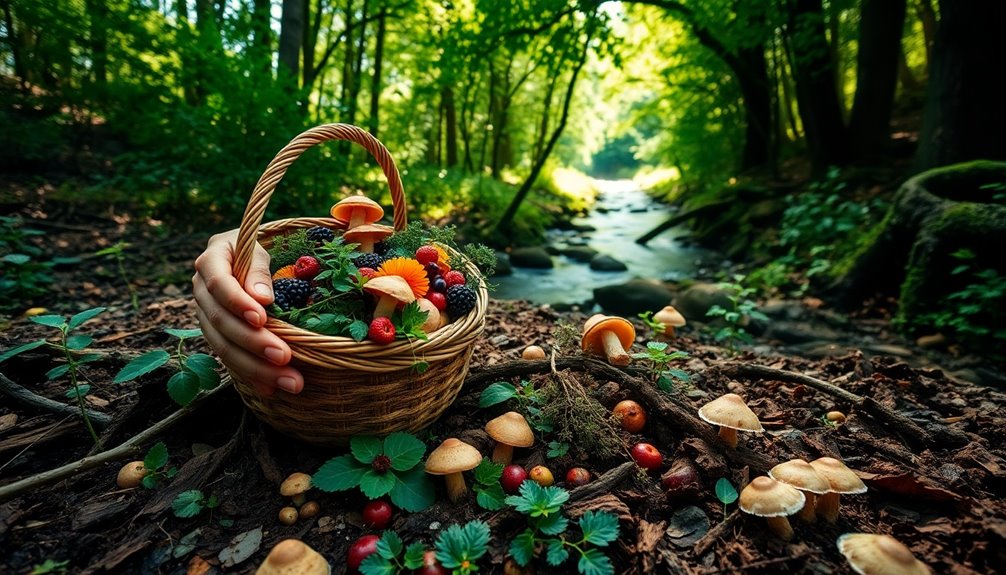
Today's foraging culture thrives on a deep appreciation for the environment and its delicate balance. As you explore local ecosystems, understanding environmental conditions and seasonal changes is essential. Different plants and animals become available at various times of the year, and your success depends on this ecological knowledge.
| Aspect | Importance | Best Practices |
|---|---|---|
| Environmental Conditions | Guides foraging strategies | Adapt to local climate |
| Seasonal Changes | Influences availability | Forage according to seasons |
| Sustainable Practices | Protects native species | Take only 5% of a patch |
| Community Engagement | Promotes reciprocity | Share knowledge and resources |
Emphasizing sustainable harvesting practices guarantees you're not depleting resources or contributing to environmental degradation. It's essential to observe the health and growth patterns of ecosystems, allowing you to make informed decisions. By leaving enough resources for wildlife and future generations, you foster a shared responsibility for natural habitats and help maintain the balance of the environment. In this way, foraging becomes not just a hobby, but a meaningful contribution to the preservation of our planet.
## Cultural Significance of Foraging
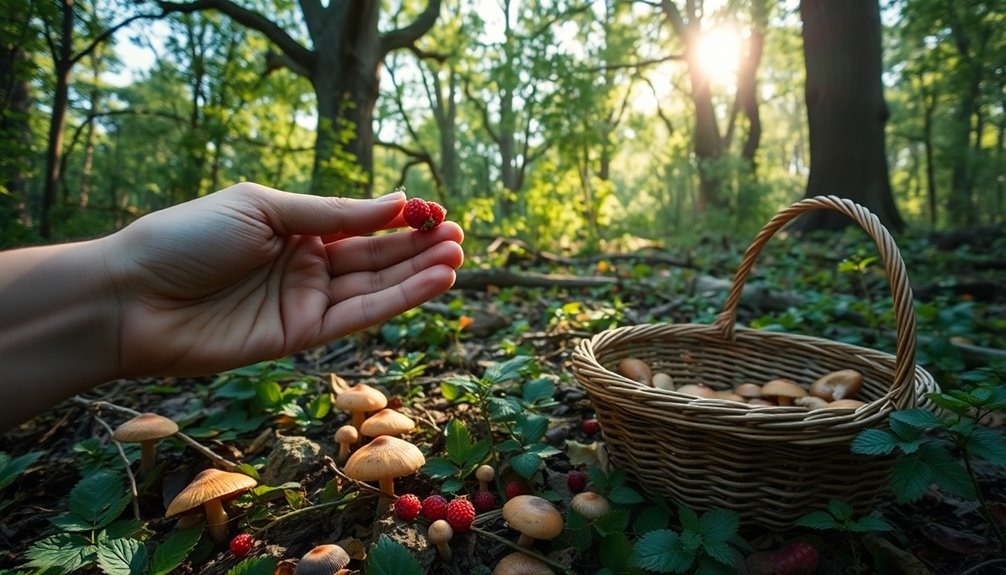
Cultivating a connection to the land through foraging reveals its profound cultural significance. This ancient practice isn't just about gathering food; it's a rich tapestry of traditions that have shaped human interaction with nature for millennia. The time spent foraging fosters communal activity, strengthening bonds among those who share the experience and knowledge.
Consider these key aspects of foraging's cultural significance:
- Cultural Heritage: Foraging embodies the traditions and rituals passed down through generations, preserving unique environmental relationships.
- Social Bonds: It encourages collaboration, as groups gather to share skills and stories, fostering community spirit.
- Spiritual Connection: Many cultures view foraging as a sacred act, reflecting a deep respect for nature and its offerings.
- Ecological Knowledge: The practice highlights the importance of traditional ecological knowledge, essential for sustainable living.
- Culinary Influence: Foraging has revitalized culinary traditions, inspiring chefs and home cooks to incorporate wild foods into their diets.
In embracing foraging today, you're not just seeking food—you're participating in a vibrant cultural heritage that celebrates our connection to the land and each other.
Frequently Asked Questions
When Did Humans Start Foraging?
You might be surprised to learn that humans have been foraging for over 2 million years. This practice allowed early humans to gather wild plants and hunt animals for food.
Foraging dominated human sustenance for 99% of our history until agriculture emerged about 12,000 years ago.
Even today, many communities continue to rely on foraging, showcasing its lasting significance and the deep connection people have with nature and their food sources.
Are All Humans Believed to Have Lived as Foragers Before 12000 Years Ago?
Yes, all humans are believed to have lived as foragers before 12,000 years ago. During this time, you relied on hunting and gathering for food, adapting to diverse environments.
As you moved through various landscapes, you developed complex strategies and social structures to enhance your survival. This foraging lifestyle shaped your ancestors' experiences and laid the groundwork for the eventual shift towards agriculture, which transformed how communities interacted with their surroundings.
Is the Oldest Form of Human Subsistence Is Foraging?
You might think agriculture's emergence overshadowed foraging, but it's actually the oldest form of human subsistence.
For over 99% of our existence, you and your ancestors thrived on wild plants, animals, and other natural resources.
Even after farming began, foraging remained essential for maintaining diverse diets and ensuring survival during tough times.
This deep-rooted practice not only nourished bodies but also connected communities, enriching cultural traditions and environmental understanding.
Were Most Humans Engaged in Foraging up Until About Years Ago?
Yes, most humans were engaged in foraging until about 12,000 years ago.
You'd find hunter-gatherers thriving in various environments, relying on diverse wild food sources for survival. This lifestyle dominated human existence for millennia, meeting nutritional needs effectively.
However, as agriculture emerged, many shifted away from foraging. Despite this, some communities continued to forage, especially during environmental changes or societal challenges, showing its lasting importance in human history.
Conclusion
As you journey through the forest of humanity's past, you discover that foraging isn't just about gathering food; it's a symphony of survival, woven into the fabric of our existence. Each berry plucked and root unearthed tells a story of adaptation and resilience. Like a river carving its path, foraging flows through cultures, shaping identities and fostering connections. Embrace this ancient dance, and you'll find that the spirit of foraging still thrives, inviting you to partake in its rich legacy.

